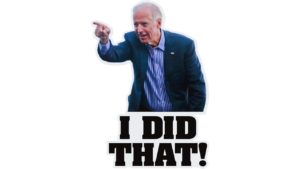 The Commerce Department has revised its first-quarter GDP numbers for 2022, showing an even deeper contraction of 1.6%. The Biden economy, with raging inflation and unsteady growth prospects, is the product of overspending, and rampant money printing by the Fed. Sarah Chaney Cambon reports in The Wall Street Journal on sentiment turning against the Biden economy, writing:
The Commerce Department has revised its first-quarter GDP numbers for 2022, showing an even deeper contraction of 1.6%. The Biden economy, with raging inflation and unsteady growth prospects, is the product of overspending, and rampant money printing by the Fed. Sarah Chaney Cambon reports in The Wall Street Journal on sentiment turning against the Biden economy, writing:
The U.S. economy entered the second quarter on shakier footing than previously thought.
Consumer spending, the economy’s main engine, was much softer in the first quarter than previously reported, according to Commerce Department gross domestic product revisions released Wednesday. Spending grew at a revised annual rate of 1.8% in the first quarter, down from a previous estimate of 3.1%.
The updated numbers revised the first-quarter contraction in economic output to an annual rate of 1.6% from 1.5%. The weaker estimate on the first three months of the year comes amid signs the economy is slowing in the second quarter, as consumers confront elevated inflation and higher interest rates.
Many economists have downgraded their forecasts for second-quarter GDP in recent weeks. Some estimate the economy expanded only slightly in the April-through-June period.
IHS Markit economists forecast second-quarter gross domestic product growth of an annualized 0.1%, weaker than 1% growth they forecast earlier this week. One closely watched forecast—the Federal Reserve Bank of Atlanta’s GDPNow tracker—estimated 0.3% annual growth in the second quarter.
“Economic momentum will likely protect the U.S. economy from recession in 2022,” said Paul Gruenwald, global chief economist at S&P Global Ratings. “But the weight of extremely high prices is damaging purchasing power.”
Spending at retailers fell in May for the first time this year, a sign consumers are struggling to stomach higher prices. Consumers’ short-term outlook for the U.S. economy dropped sharply on concerns about inflation, the Conference Board’s consumer-confidence survey showed.
Economists surveyed by The Wall Street Journal have raised the probability of recession, now putting it at 44% in the next 12 months, a level usually seen only on the brink of or during actual recessions. The likelihood of a recession has grown this year as inflationary pressures remained strong and the Federal Reserve took increasingly aggressive action to tame them.
If you’re willing to fight for Main Street America, click here to sign up for my free weekly email.




